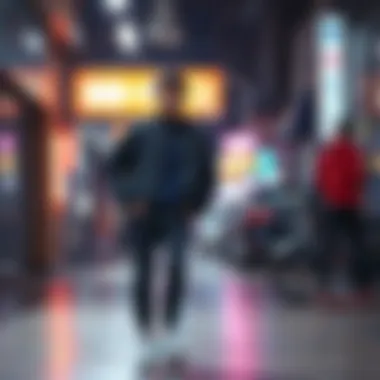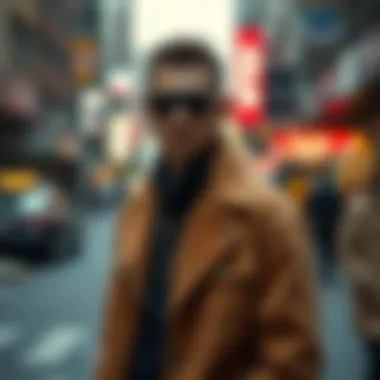Exploring 90s Men’s Fashion Trends and Styles


Intro
The 1990s was a pivotal era for fashion, especially for men. This decade is often remembered for its eclectic mix of styles, reflecting a shifting landscape where society and culture wove themselves intricately into the fabric of everyday life. From grunge and hip-hop to tailored suits and sportswear, the 90s defined a generation, leaving indelible marks that influence men's fashion even today.
In this exploration, we’ll dissect the distinctive outfits that became synonymous with the era, highlighting how various trends were born from the societal changes of the time. Whether you were rocking a flannel shirt while jamming to Nirvana or donning a sneaker and baggy jeans look straight out of a music video, the styles of 90s men are vivid symbols of a moment in time. Get ready to dive into the defining elements of 90s fashion, their cultural significance, and how they continue to resonate today.
Tips and How-Tos
When examining the unique styles of 90s men's outfits, it’s essential to know not just what to wear, but how to take care of your appearance—after all, looking good and feeling good go hand in hand.
Skincare Routines for Different Skin Types
Having healthy skin plays a vital role in enhancing any outfit. The 90s were not without their own skincare trends, some of which focused on natural looks. Here are a few tips:
- For Oily Skin: Look for foaming cleansers that help remove excess oil, and incorporate a gentle exfoliant.
- For Dry Skin: Hydration is key. Use cream-based cleansers and regularly apply moisturizer and face masks.
- For Combination Skin: A balance is essential. Use different products tailored for each zone (e.g., creams for dry patches and gel for oily areas).
Haircare and Styling Basics
Just like skin, hair is also a vital part of overall appearance. The 90s brought unique hairstyles that ranged from slicked-back looks to messy, textured styles. Here are some tips for achieving that quintessential 90s look:
- Choosing Hair Products: Use gels or mousses for volume and hold.
- Popular Styles: Try the grunge look featuring long, unkempt hair or the boy band inspired sleek styles that many adored during this decade.
- Coloring: From blond highlights to dyeing it all black, the 90s were all about experimentation. Just remember to use proper products for maintenance.
Sustainable Practices
The modern fashion landscape is gradually shifting towards sustainability, and understanding this is vital for any discerning individual. Fashion from the 90s often embraced thrift and second-hand items.
Eco-Friendly Fashion Brands
While many prominent brands have emerged, some have maintained roots in the eco-friendly movement. Keep an eye out for brands that are:
- Known for transparent manufacturing processes.
- Utilizing sustainable materials like organic cotton and recycled polyester.
Tips for Sustainable Grooming
Looking good while being kind to the planet is entirely feasible. Some sustainable grooming practices include:
- Opting for natural or organic grooming products that are free from harmful chemicals.
- Reducing consumption by buying in bulk or choosing refillable options.
Celebrating Diversity in Beauty
In the broader context of the 90s and beyond, the celebration of diverse beauty has become essential. This had roots in the fashion of the time.
Inclusive Beauty Brands
Brands that flourished during the 90s often embraced diversity. Look for inclusive brands that cater to a myriad of skin tones and hair types to find the perfect products.
Cultural Influences on Fashion
The fashion of this decade was notably influenced by various cultural elements. From hip-hop to punk, these styles brought forth a powerful blend that encouraged visionaries to express their identity unapologetically.
As we traverse the landscape of 90s fashion, it’s crucial to appreciate its resonance in today's sartorial choices, paving the way for a future built on both creativity and consciousness.
Cultural Context of 90s Fashion
Understanding the fashion of the 90s isn't just about the clothes themselves; it’s about the socio-cultural waves that shaped them. This decade was a melting pot of influential forces, giving rise to styles that were as much a reflection of the times as they were a personal statement. The significance of digging into the cultural context cannot be overstated; it helps us grasp how and why certain trends took off and what these styles meant for the generation that wore them.


The Intersection of Music and Fashion
Music was the heartbeat of the 90s, and it reverberated through the clothing choices of that time. From grunge to hip-hop, different musical genres propelled fashion into uncharted territory. Bands like Nirvana and Pearl Jam epitomized the grunge movement, where flannel shirts and ripped jeans spoke volumes about rebellion and nonconformity. The hip-hop scene, on the other hand, introduced oversized apparel and flashy accessories, showcasing individuality and confidence. The synergy between music and fashion wasn't merely coincidental—artists became style icons, and their wardrobes influenced millions.
"Fashion is a form of ugliness so intolerable that we have to alter it every six months." – Oscar Wilde
Television and Film Influence
Television and film acted as the cultural glue of the 90s, further shaping men’s fashion. Icons like Will Smith in The Fresh Prince of Bel-Air and the heartthrobs from Friends showcased styles that redefined masculinity. The dual charm of casual and preppy looks made waves, propelling brands into the spotlight. Clothing was not just a matter of personal choice; it became a social phenomenon. Shows and movies highlighted what was 'cool,' steering trends that birthed styles such as cargo pants, graphic tees, and sport jackets with an almost magnetic appeal.
Street Culture and Its Impact
Street culture served as a backdrop to the sartorial choices of the 90s. Skateboards, graffiti, and urban art were the vibrant colors on the canvas of the decade. No longer just a place for leisure, the streets became a runway full of expressive styles. Influencers from basketball courts and skateparks donned baggy shorts, high-top sneakers, and snapback hats, all while exuding an aura of effortless coolness. This direct link between fashion and street culture heralded a new era, where attire was not solely defined by high fashion but by everyday life. The 90s taught us that style could emerge from the grassroots, transcending boundaries and societal norms.
In summary, the cultural context of 90s fashion is rich and multifaceted, touching everything from music to television and street life. Each element interplayed to create a unique tapestry that defined a generation, offering insight into the complexities of identity and expression during that decade.
Core Elements of 90s Guy Outfits
The core elements of 90s guy outfits play a crucial role in understanding the fashion landscape of this expressive decade. These styles reflect not just an aesthetic choice but a cultural movement that resonated with the youth of the time. The varied elements including casual wear, denim, graphic tees, and layering techniques created a tapestry of individualistic styles that poured out from various influences such as music, street culture, and television. Recognizing these core segments allows us to appreciate how deeply intertwined fashion is with socio-cultural factors and personal identities.
Defining Casual Wear
Casual wear in the 90s shaped a lot more than just comfort. It was a signal of freedom and an embracing of individuality. The gyred jeans paired with oversized tees created a laid-back but stylish appearance, hitting the sweet spot between comfort and style. Brands like Levi's and Tommy Hilfiger played pivotal roles in popularizing these fashion choices. Key items included:
- Baggy Shorts: Often sported in bright colors or denim, they appealed to a carefree lifestyle.
- Windbreakers: Lightweight and vibrant, perfect for a quick run or casual meetup.
- Cargo Pants: Participants of the skate and grunge scene prioritized utility along with style.
Casual wear wasn’t just clothing; it represented a lifestyle. Wearing these items often indicated a rejection of traditional dress codes, symbolizing youth's push for self-expression.
The Rise of Denim
When you think of 90s fashion, denim is likely the first fabric that comes to mind. The ascent of denim was unstoppable, as it morphed into a canvas for personal expression. From jeans to jackets, denim became a go-to for men seeking versatility.
- Distressed Jeans: Popularized by grunge icons, these provided a lived-in appearance that resonated with youth culture.
- Denim Jackets: Often worn oversized, sometimes layered with flannel shirts underneath, they became a staple for casual outings.
- Canadian Tuxedos: A look that paired denim on denim; although some might have frowned upon it, it was a daring statement signifying confidence and style.
Denim's robust nature allowed it to withstand some serious wear and tear, making it an enduring choice for many guys during this decade.
Graphic Tees and Their Symbolism
Graphic tees were more than just fabric; they were a walking billboard of personal interests and social commentary. From band logos to bold statements, these shirts served as a peek into the wearer’s worldview. Many guys used graphic tees as a way to express belonging to certain music genres or subcultures.
- Band T-Shirts: Representing everything from Nirvana to The Notorious B.I.G., they celebrated a connection to music.
- Cultural References: Popular shows like Friends or movies like The Matrix had their share of themed tees, giving fans a chance to wear their passions.
- Satirical Prints: Funny slogans or political commentary played an important role in showcasing personality.
Thus, graphic tees became a form of communication among peers, often sparking conversations and connections.
Layering Techniques for Style
Layering was an art form in the 90s, turning simple outfits into more dynamic presentations. Boys experimented with different materials, colors, and styles to create unique silhouettes.
- Flannel Shirts over Tees: This was a quintessential grunge statement, infusing warmth and an effortlessly cool vibe.
- Hoodies under Jackets: Creating a snug look, it balanced function with style, appealing to those who enjoyed streetwear.
- Long Sleeves under Short Sleeves: A memorable trend that allowed for playful layering, accompanying a variety of textures and colors.
In layering, it was often about the interplay of textures and the clever use of colors. It allowed individuality to shine through, inviting creativity and exploration.
"Fashion is about expressing who you are without saying a word."
Overall, the core elements of 90s guy outfits not only defined the fashion statements of the era but also left an indelible mark on how men express themselves today. The legacy of these styles can still be felt, as they are being rediscovered and reinterpreted in various contemporary forms.


Iconic 90s Outfit Styles
The 90s represented a unique blend of styles, and the outfits of that era continue to make waves in contemporary fashion. The decade showcased diverse aesthetics, enabling men to express their individuality through clothing. From grunge to preppy, each style carried its own narrative, influenced by music, culture, and societal shifts. This section will explore these iconic outfit styles, shedding light on their significance and lasting impact.
The Grunge Movement
Grunge was more than just a style; it was a cultural revolution that emerged from the music scene, particularly from the Pacific Northwest. This movement championed authenticity and anti-establishment sentiments.
Key Pieces
When discussing key pieces of the grunge movement, flannel shirts, ripped jeans, and combat boots come to mind. These items were perfect embodiments of comfort and rebellion. Flannel shirts, often worn oversized and unbuttoned, allowed for ease of movement, a primary characteristic of the grunge ethos. The distinct look provided an almost effortless vibe, gaining popularity due to its candid authenticity. Rip in denim pants provided a worn-in feel, suggesting a disregard for conventional aesthetics and tradition. This nonchalance contributed to grunge’s allure, allowing individuals to connect with a broader cultural statement rather than just clothing choices.
Influential Figures
When it comes to influential figures, Kurt Cobain reigns supreme. His rugged style and persona transcended music, solidifying him as a fashion icon of the 90s. Characters from popular culture, like Eddie Vedder of Pearl Jam and Chris Cornell from Soundgarden, also left their mark. Their looks often exemplified the grunge aesthetic through layered outfits paired with unique hairstyles. Cobain's penchant for thrifted finds and a mix of high and low fashion choices showcased a distinct yet relatable quality, hinting at grunge’s deep roots in youth culture and resistance.
Hip-Hop Influences
The 90s marked the rise of hip-hop, which influenced not only music but also fashion in profound ways. This era produced styles that represented confidence and cultural pride.
Baggy Pants and Oversized Shirts
Baggy pants and oversized shirts became a thing in hip-hop fashion. The relaxed fit of these clothes allowed for freedom of movement, which was essential for dancers and performers. The oversized silhouette was also symbolic; it challenged traditional norms of masculinity and elegance in men’s fashion. This contrast was refreshing and engaging, appealing to a wide audience who sought to break away from more tailored looks. Big and bold, these pieces often featured vibrant colors and graphics, resonating with a sense of empowerment.
Sneaker Culture
Along with oversized clothing, sneaker culture cemented itself as an essential aspect of 90s hip-hop fashion, mixing performance with style. Sneakers, especially models like the Air Jordan series by Nike, represented more than just footwear; they became status symbols. Prominent athletes and rappers turned these kicks into icons, with bright colors and innovative designs capturing attention. Sneakerheads in this era bolstered a culture around exclusivity and ownership, which continues to thrive today. The variety allowed for individual expression, making it difficult to exaggerate its importance in defining 90s fashion.
Preppy Styles
In contrast to the aforementioned movements, preppy styles during the 90s diluted some of the more rebellious tones seen in grunge and hip-hop. This style represented a refined aesthetic, often rooted in traditional fashion elements but adapted to appeal to the youth.
Chinos and Polo Shirts
Chinos and polo shirts defined preppy outfits in the 90s. The tailored look offered sophistication while maintaining a casual vibe. The versatility of chinos made them suitable for many occasions, from lounging at home to attending family gatherings. Polo shirts—especially from brands like Ralph Lauren—came with a built-in sense of prestige and heritage. The clean lines and choice of colors were appealing, making this style relatable for young men who sought to navigate both casual and formal environments. The downside, however, was that some viewed this look as elitist, which could alienate those preferring more expressive styles.
Influencers in the Preppy Scene
Influencers in the preppy scene, notable figures like Matthew McConaughey and brands that epitomized the style, played significant roles. These influencers showcased how to wear classic pieces in contemporary ways. With their built-in association with affluence and a leisurely lifestyle, preppy models became aspirational figures for many. Yet, these representations sometimes faced criticism for promoting exclusivity rather than diversity in fashion representation.
Rave Culture Fashion
As a response to the 90s nightlife scene, rave culture introduced a bold, vibrant aesthetic that was heavily focused on self-expression.
Bright Colors and Patterns
Bright colors and patterns became central to rave fashion, reflecting the energy and spontaneity of the movement. Fluorescent outfits, often made from lightweight materials, allowed participants to stand out in dark club environments. The eclectic mix of patterns and graphics symbolized a rejection of convention, embracing chaos and individuality. The unique feature of using materials like mesh and cyber-inspired designs was both a blessing and a curse—practical in terms of comfort, but sometimes criticized for lacking substance.
Key Accessories
Key accessories definitely elevated rave outfits. From glow sticks to oversized sunglasses, these items played vital roles in enhancing the overall experience. They allowed individuals to engage with the atmosphere, diving deeper into the communal and immersive aspects of rave culture. However, some viewed these accessories as gimmicks that detracted from the fashion overall, sparking debates about the authenticity of the look.
Accessories That Completed the Look
Accessories in the realm of 90s fashion were more than just decorative pieces; they played a pivotal role in defining individual styles and making bold statements. From hats to footwear and jewelry, these elements allowed men of the decade to express their identities, often challenging societal norms through personal style choices. The right accessory could escalate a simple outfit into something striking, catching the eye and leaving an impression. This section dives into three main accessories that were instrumental in shaping 90s guy outfits: hats, footwear, and jewelry.


Hats: The Styles That Made Statements
When discussing 90s fashion, hats often take center stage. They acted as both functional items and powerful style statements. Styles like the baseball cap, beanies, and bucket hats each carried specific connotations that resonated with various subcultures. For instance, a baseball cap often signified casual, laid-back vibes while a beanie could suggest a more edgy, grunge aesthetic.
The versatility of hats during this decade cannot be overlooked. For example, the wide-brimmed hats often worn by hip-hop artists brought forth an added layer of flair to outfits, showcasing an effortless cool. Meanwhile, bucket hats, popularized by figures in the rave scene, symbolized a carefree attitude.
In addition to aesthetics, hats also offered practical benefits such as sun protection and warmth in cooler weather, intersecting functionality with style elegantly. They could either complement or completely transform an outfit; a simple t-shirt and jeans ensemble could instantly be elevated with the addition of a well-chosen hat.
Footwear Trends
Footwear was paramount to the 90s aesthetic, dictating much of the overall vibe of an outfit. Two primary styles dominated this era: combat boots and classic sneakers, each bringing its own ethos and style identity.
Combat Boots
Combat boots, typified by their sturdy construction and rugged appearance, became a fashion staple by the mid-90s. Their key characteristic lay in their ability to pair with a myriad of styles, from grunge to punk, meanwhile providing an aura of toughness. They were often embraced by those who wanted to reflect a more rebellious spirit. Wearing combat boots blended practicality with an edgy aesthetic, allowing individuals to make a distinctly bold fashion statement.
A unique feature of these boots was their adaptability; they could transition from day to night seamlessly. While they offered strength and comfort, their weight could be a consideration for some, making them less than ideal for prolonged wear. Nevertheless, in the realm of 90s fashion, their contribution was undeniable.
Classic Sneakers
Classic sneakers, embodying simplicity and casual comfort, were another footwear choice that defined the decade. Brands like Nike, Adidas, and Converse dominated the landscape. Key characteristics included their sleek lines and the ability to be dressed up or down, making them suitable for various settings, from skate parks to mainstream gatherings.
The unique feature of classic sneakers was the wide range of designs and colors that allowed for extensive personal expression. Unlike combat boots, they were lightweight and comfortable, giving an edge in daily wearability. Their enduring popularity is evident, as these sneakers remain prevalent in modern wardrobes, illustrating their timeless appeal in the sneaker culture.
Jewelry and Personal Adornments
In the aggregation of 90s accessories, jewelry held a significant role. It often complemented outfits, filling in the gaps left by clothing choices. Within the male population, items like friendship bracelets and chokers became emblematic of the decade. Layered necklaces with pendants showed a blend of casual style with nostalgia, often utilizing materials like leather and beads.
The rise of personalization through jewelry was not just about adornment but also about storytelling. Men often wore pieces that symbolized beliefs, interests, or affiliations, hence making jewelry an extension of their identity.
In summation, the accessories of the 90s not only completed outfits but helped in ferreting out individual expression amidst a conservative fashion landscape. The choices of hats, footwear, and jewelry provided men avenues to explore and articulate their personal styles, building a fashion legacy that continues to influence today.
The Legacy of 90s Fashion Today
The significance of 90s fashion in the present day cannot be overstated. The unique styles that emerged from this decade not only reflected the socio-cultural fabric of the time but also laid the groundwork for contemporary fashion trends. As such, exploring the legacy of 90s fashion offers valuable insights into how past influences shape our present and future sartorial choices.
While some might say that fashion is fleeting, the resurgence of 90s aesthetics in today’s wardrobes signifies a deeper connection with nostalgia and individual expression. More than mere clothing, these outfits serve as a canvas where history and personal identity intersect.
Influence on Contemporary Fashion
The impact of 90s fashion on modern styles is glaringly obvious. Designers are often seen drawing inspiration from the vivid colors, bold patterns, and unique cuts that defined the era. The likes of Marc Jacobs and Tommy Hilfiger have infused past trends into their collections, revamping them for newer audiences.
Trends like oversized silhouettes, sporty ensembles, and casual wear are back on the rise, almost as if they never truly left. Streetwear brands also borrow heavily from the aesthetic, uniting function with a sense of playful rebellion. It creates a kind of nostalgia that resonates with both those who lived through the 90s and those who seek to tap into that visual culture today.
Revival of Vintage Styles
The Thrift Culture
The thrift culture is a focal point in the revival of vintage styles. This movement encourages folks to rediscover and celebrate unique pieces from the past, specifically those from the 90s, providing a sustainable alternative to fast fashion. The allure lies in the hunt for hidden gems—clothes that carry a history all their own. Shopping at thrift stores or flea markets often unveils one-of-a-kind items that you won’t find on typical retail racks.
Moreover, thrift culture fosters creativity and individuality. By mixing contemporary pieces with retro finds, individuals can create highly personalized outfits that stand out in a mass-produced world. Still, it’s not without its disadvantages; finding quality items can be hit or miss. However, the thrill of the chase is part of the charm.
Modern Adaptations of Classic Looks
Modern adaptations of classic looks also play a significant role. Designers creatively reinterpret signature 90s styles, like using oversized flannel shirts or baggy jeans, but with contemporary fabrics and cuts. These adaptations keep the spirit of the original styles alive while ensuring that they remain relevant in today’s fashion landscape.
This approach offers another option for those seeking unique expression in their wardrobes. It provides versatility—classic styles can transition smoothly from casual outings to semi-formal events with just a few tweaks. However, it can also lead some to feel that these adaptations lack the authenticity of the originals, creating a tension between nostalgia and modernity.
Sustainability in Retro Fashion
Lastly, sustainability emerges as a key consideration in the context of retro fashion. As consumers become increasingly aware of the environmental costs associated with fast fashion, the appeal of 90s styles—typically simpler and often supported by sustainable practices—offers a ripe opportunity for change. By opting for vintage or thrifted clothing, individuals contribute positively to the fashion cycle, reducing waste and promoting ethical consumption.







